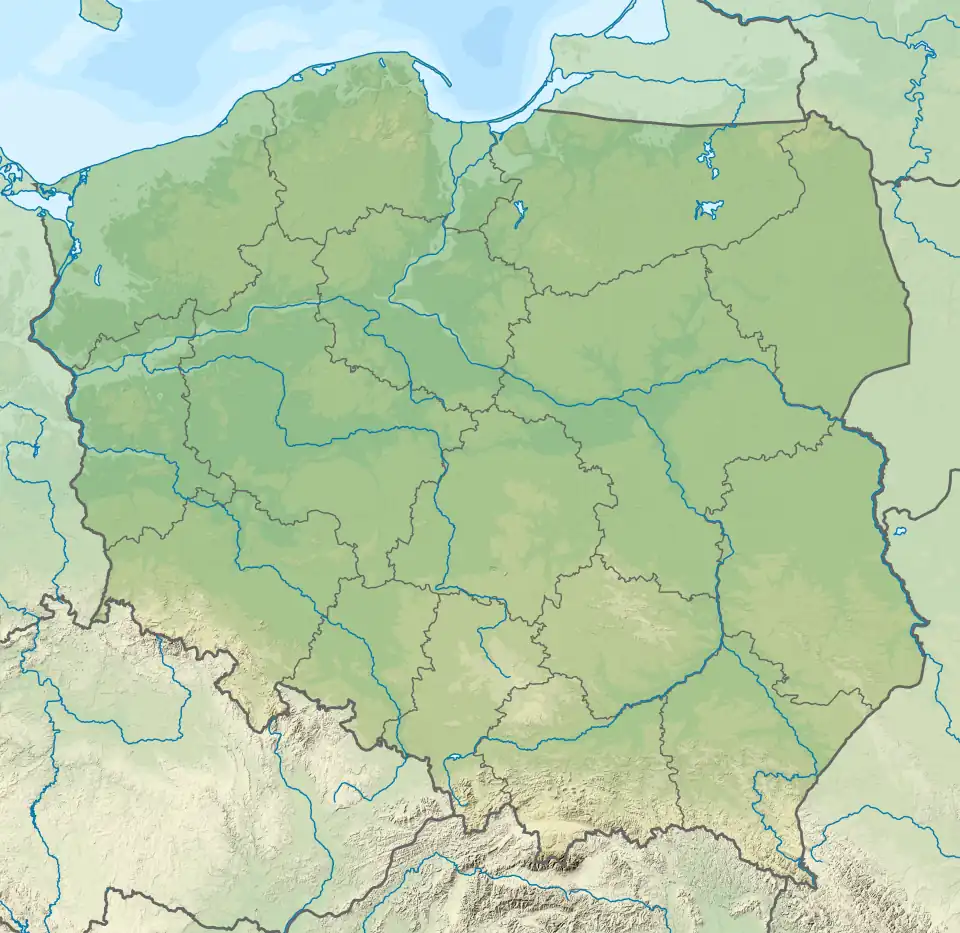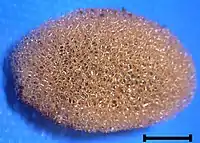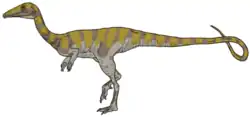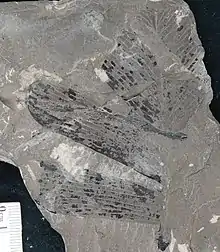| Borucice Formation | |
|---|---|
| Stratigraphic range: Middle-Late Toarcian ~ | |
| Type | Geological formation |
| Unit of | Kamienna Group |
| Sub-units | Idzikowice Tracksite |
| Underlies |
|
| Overlies |
|
| Area | Polish Basin |
| Thickness | 120 m (390 ft) |
| Lithology | |
| Primary | Coarse-fine-grained sandstone |
| Other | Mudstone |
| Location | |
| Country | |
| Type section | |
| Named for | after the village of Borucice in Kujawy[1] |
| Named by | Stefan Zbigniew Różycki (as Borucice Series)[1][2] |
| Year defined | 1958 |
 Borucice Formation (Poland) Original Outcrop Location | |
The Borucice Formation, also known in older literature as the Borucice Series, is a Jurassic (Middle-Late Toarcian) geologic formation that extends to nearly whole of Poland.[3][4] This formation represents the last sequence of the lower Jurassic in Poland, recovering the depositional sequences IX and X, and may even recover lowermost parts of the first Middle Jurassic sequence.[4] It represents mostly a series of alluvial (braided or meandering channel) depositional systems with subordinate intervals of deltaic deposits. Dinosaur Tracks are among the fossils that have been recovered from the formation. Most of the sediments of the Polish realm come from deltaic, fluvial and marine deposits.[5] It mainly consists of light whitish-grey, fine grained sandstones interbedded by clay containing plant detritus and minute fragments of coal. It also has dark grey mudstones with marine lamellibranches and an Upper Lias microfauna.[2] Its main equivalents are the Jurensismergel Formation of Germany, upper part of the Rya Formation (Southern Sweden)and the uppermost Sorthat Formation (Bornholm).[1] There are also coeval abandoned informal units in Poland: Upper Lisiec beds (Czêstochowa region), or the Kamień Beds (Pomerania region).[1]
Sedimentological evolution
On the Częstochowa region the sequences IX and X are developed mostly as alluvial, meandering river deposits with subordinate lacustrine lithofacies.[1] The Deltaic deposits are found on the Suliszowice 38 BN Borehole and the arki 89 ¯ borehole, and show how these delta deposits were preceded by a short-lived brackish-marine ingression associated with lagoonal mudstones and heteroliths.[1] The mudstone layers show high boron, along with the presence of pyrite concretions and more abundant Fodinichnia.[1] The local delta episode is reported from the depositional sequence IX, while the sequence X is developed as alluvial deposits (sandstones with trough cross bedding and rich plant fossils) with some intercalations of lacustrine deposits.[1]
On the Pomerania region the formation starts with a depositional sequence IX that begins with a common erosional surface seen on the Mechowo IG 1 borehole exposed by medium-to-fine-grained sandstones with trough cross bedding and horizontal bedding, that come from a series of from alluvial channels to distributary channels on depositional subsystems.[1] It is overlaid by sediments composed by mudstone and heterolithic lithofacies that point to a rise in the level of the local water, but unclear if derived from a sea ingression or from alluvial floodplain deposits, delta plain deposits or, delta-front deposits.[1] There are present coarsening-upwards cycles as well as slightly elevated boron content, which point to the dominated deposition of a delta.[1] The Depositional sequence X is composed mostly of a thin sedimentary package of coarse alluvial sediments resting on the erosional surface and topped with a thin mudstone bed with the Paxillitriletes phyllicus spore.[1]
Stratygraphic profile
The profiles recovered between Aleksandrów Kujawski and Rogoźno on the Kuyavian-Pomeranian Voivodeship the Borucice Formation is known as the top of the sandstone series.[6] There level is composed mostly by an admixture of coarse grain sandstone, which mark the beginning of a new sedimentary cycle.[6] It has inserts of clayey Clay loupes present as a subordinate role. Is disposed along the Krogniewice series, composed of sandstones, in its main mass probably containing only thin and rarely broken clay inserts, while in the uppermost part there is abundant inserts. This part of the highest level is the equivalent of multiple phases of levels VI A and VI B in the vicinity of Kiodawa.[6] Apparently, there is a lack of VI C level flashers in Krogniewice, which are eroded before the Aalenian level. Locally, the border section Middle/Lower Jurassic wasn't worked and the location of it wasn't completely solved. The Borucice Formation has a thickness here of 100–150 m. Overlaying the formation, is covered with transgression Aalenian sea sediments, where the transition, if exists, is gradual and small.[6]
| Unit | Lithology | Thickness (metres) | Palynology | Fossil Fauna |
|---|---|---|---|---|
|
Youngest |
0.3 m of fine-grained gray sandstone, poorly preserved core, illegible layering; 0.7 m of medium-grained, gray sandstone, poorly preserved core, illegible layering |
753.9–760.7 m; thickness 7 m |
Non Reported |
Non Reported |
|
N1 |
0.5 m - fine-grained, gray sandstone, poorly preserved core, illegible layering; 0.3 m of gray mudstone, horizontal lamination; 2.4 m of core with medium-grained gray sandstone, silt clusters in the upper and lower part, in the bottom large diameter (a few centimeters), made of green clay and siderite pebbles ilaste (erosion of underlying tracks). A clear erosive surface at a depth of 767.4 m is sequence limit |
760.7–767.4 3.2 m of core |
|
Non Reported |
| Unit | Lithology | Thickness (metres) | Fossil Palynology/Flora | Fossil Fauna |
|---|---|---|---|---|
|
Upper complex[8] |
Light gray sandstones, fine and medium-grained, infused with silt and light gray and gray yellows; in the lower part more numerous medium-grain inserts; numerous remains of flora, muscovite, pyrite concentrations. |
40–55 m |
| |
|
Medium complex[8] |
Fine-grained sandstones with numerous overflows of clayey and rhizoids, of dark gray and gray mudstones, prelate avenues; flora, mica. |
40–45 m |
| |
|
Lower complex[8] |
Fine-grained sandstones with overgrowth of loam and gray mudstones, numerous in the upper part; Shoals of translators; pyrite, fine mica, flora. |
45 m |
| |
Annelida
| Genus | Species | Stratigraphic position | Material | Notes | Images |
|---|---|---|---|---|---|
|
Dictyothylakos[9] |
|
|
Cocoons |
Freshwater Clitellata Cocoons (Oligochaeta and Hirudinea), identified with palynological residues, and thought to be tridimensional nets of probable algal origin.[10] Fragmentary mesh-like networks of hapsine threads composed of a homogenous translucent material. They show the outer wall (hapsine) construction specific to clitellate annelids and lack an alytine (inner) layer. A disorderly meshwork of the hapsine layer and hapsine fibres of unequal thickness, are diagnostic of the type species Dictyothylakos pesslerae. The cocoons Dictyothylakos pesslerae resemble specially those of modern Leechs, and are common on flooded basin sediments, what implies not only the presence of parasitic leeches, but also the presence of large hosts nearby, what has been confirmed on the case of the Borucice Formation, thanks to the presence of dinosaur Footprints. |
 Example of leech cocoon .jpeg.webp) Placobdella, example of leech |
Actinopteri
| Genus | Species | Location | Material | Notes | Images |
|---|---|---|---|---|---|
|
Palaeoniscidae Indeterminate |
|
|
A Freshwater Osteichthyes, member of the family Palaeoniscidae inside Palaeonisciformes. Is similar to the genus Oxygnathus from the Sinemurian of England, though this last one is a preoccupied name shared with a beetle and comes from marine deposits. The presence of fish locally bolsters the case for persistent, deep interplain lakes where this fishes probably lived. The teeth assigned have multidenticulate appearance, that is linked with benthic scraping, and fished that fed primarily on algae. One genus of Paleonisciform, Hemicalypterus weiri from the late Triassic Chinle Formation is known to have that kind of dentition. |
||
Dinosauria
| Genus | Species | Location | Material | Notes | Images |
|---|---|---|---|---|---|
|
|
Footprints |
Theropod tracks, type member of the ichnofamily Anchisauripodidae, incertae sedis inside Neotheropoda. Assigned to Coelophysidae-alike dinosaurs. Small to medium slender primitive predatory dinosaurs, related with genera such as Liliensternus, Tachiraptor, Zupaysaurus, Procompsognathus or contemporaneous taxa such as the North American Segisaurus. |
 Anchisauripus footprints belong to a genus similar to Procompsognathus | |
|
|
Footprints |
Theropod tracks, member of the ichnofamily Eubrontidae, incertae sedis inside Neotheropoda. The footprints from Smilow are small-sized, tridactyl and relatively narrow. forms Assigned to Coelophysidae-alike dinosaurs. |
 Grallator footprints belong to a genus similar to Camposaurus | |
|
|
Footprints |
Theropod tracks, member of the ichnofamily Eubrontidae, incertae sedis inside Theropoda. They have resemblance with the non-Tetanureae Sinosaurus, but match with Late Jurassic Orionides trackmakers. The distinct phalangeal pads make unsure to distinguish Therangospodus from Megalosauripus.[15] |
 Therangospodus footprints can belong to relative of Magnosaurus | |
|
|
Footprints |
Ornithischian tracks, member of the ichnofamily Anomoepodidae, incertae sedis inside Ornithischia. This tracks resemble Middle Jurassic Ichnotaxa |
 Trisauropodiscus footprints can belong to relative of Hexinlusaurus | |
Palynology
The Polish Toarcian Palynology is assigned to the Paxillitriletes phyllicus (Ph) level (Isoetales), due to the abundance of this genus.[16] The lower part of the Toarcian level is even marked by the numerous occurrences of this species, sometimes also slightly precede the appearance of the genera Erlansonisporites sparassis (Selaginella-like) and Minerisporites volucris (Isoetaceae), as shown on the Gorzów Wlkp. IG 1 Borehole.[16] While the uppermost part is marked by a notorious decrease on the genus.[16] The most common species found in Poland in this interval include: Erlansonisporites sparassis, E. excavatus, Minerisporites volucris and Biharisporites scaber (Lycopodiopsida), with Aneuletes potera (Selaginellaceae) and Trileites murrayi (Selaginellaceae) on the upper levels.[16] The Toarcian disturbance of the carbon cycle, recorded on the Ciechocinek formation, coincides roughly with the appearance of Paxillitriletes phyllicus, that comes also with a clear change on the type of dominant palynomorphs recovered, changing from the predominance of pollen grains in the Upper Pliensbachian to Megaespores, what indicates a rather significant climate change, from moderate and relatively dry in late Pliensbachian to warm and humid in the early Toarcian.[16] This shift on the local climate does correlate temporarily with a global maritime transgression, which allows the exact stratigraphic-sequential correlation of this event, where the initial volcanism in the volcanic province Karoo-Ferrar rise the global temperature and generating rapid abnormalities in the carbon cycle, manifested in the form of the super-greenhouse effect in the atmospheric system.[16] Moreover, the mass occurrence of megaspore Paxillitriletes phyllicus correlate with the mentioned pulses and thus with extremely repetitive episodes hot and humid (greenhouse) climate, as the flora appears to be dominated by the family Isoetaceae, extremely hydrophilic, needing standing water to reproduction.[16]
The Borucice Formation is where Paxillitriletes phyllicus drops significantly, which indicates a return to a more moderate climate during sedimentation, corresponding to the post-variabilis age, and related with drier conditions of the Middle Toarcian, as recovered in places such as the Raasay Ironstone Formation of the Inner Hebrides. It is measured also on the Lusitanian Basin or on Yorkshire. The Changes on the flora are also correlated with the more fluvial sedimentation of the Formation.[16]
Plant Remains
The local material comes from the plant-rich, Floodplain Claystones of the Borucice Formation (on the Ciechocinek IG 1 borehole). The formation is composed mostly of fluvial sandstones, less frequently of fine-grained deposits, mostly channel fill deposits in the lower part, and crevasse splay and floodplain deposits in the upper part.[17]
| Genus | Species | Stratigraphic position | Material | Notes | Images |
|---|---|---|---|---|---|
|
|
One Incomplete Pinna |
Affinities with Matoniaceae inside Gleicheniales. Leaves of medium-sized ferns, related to modern Matonia. This type of ferns are found on tropical-humid environments, where they form large-scale colonies with +1000 individuals. The genus Laccopteris was synonymized with Phlebopteris elegans. The species has a characteristic venation, not really typical of the genus, in which the veins usually form meshes, at least at the midrib. |
 Fossil Phlebopteris | |
|
|
Pinnae |
Affinities with the Peltaspermales inside Pteridospermatophyta. Bipinnate leaves, rachis longitudinally striated, with a long petiole and secondary rachises inserted oppositely to suboppositely on the upper side of the primary rachis. This Leaves belong to large Aboreal Ferns related with dry environments. |
||
|
|
Pinnae |
Affinities with the Bennettitales inside Bennettitopsida. A more arbustive type of Bennetite, abundant on the Pliensbachian-Toarcian strata along Eurasia, related to rather dry climates. The specimen displays a considerable similarity to Otozamites falsus from the deposits of the Lower Deltaic Series of Scarborough, England. |
.jpg.webp) | |
|
|
Pinnae |
Affinities with the Williamsoniaceae inside Bennettitopsida. Leaves from Arboreal Bennetites, similar to the modern Cyca Encephalartos woodii, with robust Trunks, built for Dry and hot climates. |
 | |
|
Cycadolepis[18] |
|
|
Bennettitalean cone scales |
Affinities with the Cycadeoidaceae inside Bennettitales. |
|
|
|
Bennettitalean cone scales |
Affinities with Cycadales inside Cycadopsida. |
 Ctenis specimen | |
|
Bilsdalea[18] |
|
|
Four pieces of cuticles |
Incertae sedis affinities inside Pinales. |
|
|
|
Three leaf fragments with apex, one fragment of cuticle, found on separate rock |
Affinities with the Miroviaceae inside Pinales. |
||
|
|
Terminal leafy shoot fragments |
Affinities with the Cheirolepidiaceae or Araucariaceae inside Pinales. This species is only known from the Middle Jurassic of Wildtshire. |
||
Economical resources
Different options of hydrogen reservoirs underground storage were studied at the Łeba Elevation, Fore-Sudetic Monocline, Carpathian Foredeep, and salt stocks in the Polish Lowlands. The Borucice Formation covered in turn by Middle Jurassic fine-grained clastics especially of Aalenian and Bajocian age. The open porosity commonly ranges from 15% to 20% and pore water salinity reaches 200 g/L.[21]
CO2 storage of this formation has been view on several locations, such as the Kamionki Anticline.[22] The measured best conditions for geologic CO2 storage are displayed on the Borucice Beds and Lower Aalenian sandstones (Upper Sławęcin Beds) occurring below the Upper Aalenian clay-mud cap.[23] On the Zaosie Anticline various aquifers for CO2 storage were reviewed, including two Lower Jurassic ones: Borucice Formation and the Pliensbachian Komorowo Formation[24] The Borucice storage was tested in the boreholes of Zaosie 1 (at 500.0–665.0 m), Zaosie 2 (at 518.0–686.0 m), Zaosie 3 (at 537.0–680.0 m) and Budziszewice IG-1 (at 649.0–850.0 m), showing good reservoir properties (in terms of geological structure, thickness, lithology and physico-chemical characteristics) and is probably infiltrated by surface waters.[24] The volumetric CO2 storage capacity was calculated on approximately 222 million tons.[24] But due to the small depth of the aquifer, the Borucice Formation did not meet the requirements for a major CO2 storage.[24]
Gostynin region has shown favourable geothermal conditions Lower-Middle Jurassic formations, with the Gostynin IG-1/1a Borehole (at 2290–2245 m depth) used for preliminary evaluation of balneological properties and thermodynamical status of these waters.[25] The Borucice Formation (at 2702.6 – 2661.8 m; 2615–2605; 2310 – 2096.4 m), the occurrence of brines with Total Dissolved Solids from 99.4 to 110.0 g/dm3 was confirmed, characterized by low alteration of its chemical composition.[25]
See also
References
- 1 2 3 4 5 6 7 8 9 10 11 12 Pieñkowski, G. (2004). "The epicontinental Lower Jurassic of Poland". Polish Geological Institute Special Papers. 12 (1): 1–154. S2CID 128922070.
- 1 2 Rózycki, S.Z. (1958). "Dolna jura poludniowych Kujaw". Biul. Inst. Geol. 133 (1): 1–99.
- 1 2 Кopik, J. (1953). "Jura środkowa w wierceniu "Borucice" koło Łęczycy". LNST. Geol. Archiwum Rękopisów. 6 (3): 23–56.
- 1 2 Barth, G.; Pieńkowski, G.; Zimmermann, J.; Franz, M.; Kuhlmann, G. (2018). "Palaeogeographical evolution of the Lower Jurassic: high-resolution biostratigraphy and sequence stratigraphy in the Central European Basin". Geological Society, London, Special Publications. 469 (1): 341–369. Bibcode:2018GSLSP.469..341B. doi:10.1144/SP469.8. S2CID 134043668. Retrieved 8 September 2021.
- ↑ Leonowicz, P. (2005). "The Ciechocinek Formation (Lower Jurassic) of SW Poland: petrology of green clastic rocks". Geological Quarterly. 49 (3): 317–330. Retrieved 21 December 2021.
- 1 2 3 4 Dadlez, R. (1968). "Profil liasu w Krośniewicach (Kujawy)". Przegląd Geologiczny. 16 (10): 449.
- ↑ Czapowski, G.; Dadlez, R.; Feldman-Olszewska, A.; Gortyńska, S.; Jaskowiak-Schoeneichowa, M.; Kasiński, J.R.; Znosko, J. (2014). "Szczegółowy profil litologiczno-stratygraficzny: Gorzów Wielkopolski IG" (PDF). Polska Bibliografia Naukowa. 144 (1): 1–378. Retrieved 21 December 2021.
- 1 2 3 4 Karaszewski, W. (1960). "Nowy podział liasu świętokrzyskiego". Geological Quarterly. 4 (4): 899–920. Retrieved 7 January 2022.
- ↑ Marcinkiewicz, T. (1971). "The stratigraphy of the Rhaetian and Liasin Poland based on megaspore investigations [ Stratygrafia Retyku i Liasu w Polsce na Podstawie badan megasporowych. ]". Prace Instytut Geologiczny,(Warsaw). 65 (1): 1–57.
- ↑ Manum, S.B.; Bose, M.N.; Sawyer, R.T. (1992). "Seeds (Burejospermum Krassilov) and palynomorphs (Dictyothylakos Horst) with a netted wall structure reinterpreted: Clitellate cocoons". Courier Forschungsinstitut Senckenberg. 147 (1): 399–404. Retrieved 21 December 2021.
- ↑ Niedźwiedzki, G.; Remin, Z.; Roszkowska, J.; Meissner, U. (2008). "New finds of dinosaur tracks in the Liassic strata of the Holy Cross Mountains, Poland". Przegląd Geologiczny. 57 (1): 252–262. Retrieved 12 October 2021.
- ↑ Niedźwiedzki, G.; Remin, Z.; Roszkowska, J.; Meissner, U. (2009). "Nowe znaleziska tropów dinozaurów z osadów liasowych Gór Œwiętokrzyskich" (PDF). Przegląd Geologiczny. 57 (3): 252–262. Retrieved 7 January 2022.
- 1 2 3 4 Pacyna, G.; Ziaja, J.; Barbacka, M.; Pieńkowski, G.; Jarzynka, A.; Niedźwiedzki, G. (2022). "Early Jurassic dinosaur-dominated track assemblages, floristic and environmental changes in the Holy Cross Mountains region, Poland". Geological Quarterly. 66 (3): 66–29. doi:10.7306/gq.1660. S2CID 253535115. Retrieved 2 June 2023.
- ↑ Gierlinski, G.; Niedzwiedzki, G.; Pienkowski, G. (2001). "Gigantic footprint of a theropod dinosaur in the Early Jurassic of Poland" (PDF). Acta Palaeontologica Polonica. 46 (3): 12–21. Retrieved 7 January 2022.
- ↑ Razzolini, N. L.; Belvedere, M.; Marty, D.; Paratte, G.; Lovis, C.; Cattin, M.; Meyer, C. A. (2017). "Megalosauripus transjuranicus ichnosp. nov. A new Late Jurassic theropod ichnotaxon from NW Switzerland and implications for tridactyl dinosaur ichnology and ichnotaxomy". PLOS ONE. 12 (7): e0180289. Bibcode:2017PLoSO..1280289R. doi:10.1371/journal.pone.0180289. PMC 5513421. PMID 28715504.
- 1 2 3 4 5 6 7 8 Marcinkiewicz, T.; Fijałkowska-Mader, A.; Pieńkowski, G. (2014). "Megaspore zones of the epicontinental Triassic and Jurassic deposits in Poland–overview. Biuletyn Państwowego". Instytutu Geologicznego. 457 (7): 15–42.
- 1 2 Barbacka, M.; Pacyna, G.; Feldman-Olszewska, A.; Ziaja, J.; Bodor, E. (2014). "Triassic-Jurassic flora of Poland; floristical support of climatic changes" (PDF). Acta Geologica Polonica. 64 (3): 281–309. Bibcode:2014AcGeP..64..281B. doi:10.2478/agp-2014-0015. S2CID 128835583. Retrieved 7 January 2022.
- 1 2 3 4 5 6 7 Barbacka, Maria; Górecki, Artur; Ziaja, Jadwiga; Jarzynka, Agata; Pacyna, Grzegorz (2021). "Macrofloral and microfloral changes in the Middle Jurassic plant assemblages of the Cianowice 2 borehole (southern Poland)". Comptes Rendus Palevol. 20 (34): 701–739. doi:10.5852/cr-palevol2021v20a34. S2CID 238735388. Retrieved 23 December 2021.
- ↑ Marcinkiewicz, T. (1973). "Otozamites falsus (Bennettitales) from the Upper Liassic of the Holy Cross Mts, Poland" (PDF). Acta Palaeontologica Polonica. 18 (2): 141–163. Retrieved 7 January 2022.
- ↑ Pacyna, G. (2013). "Critical review of research on the Lower Jurassic flora of Poland". Acta Palaeobotanica. 53 (2): 141–163. doi:10.2478/acpa-2013-0015. S2CID 129464899. Retrieved 13 October 2021.
- ↑ Tarkowski, R. (2017). "Perspectives of using the geological subsurface for hydrogen storage in Poland". International Journal of Hydrogen Energy. 42 (1): 347–355. doi:10.1016/j.ijhydene.2016.10.136. Retrieved 7 January 2022.
- ↑ Marek, S; Dziewinska, L.; Tarkowski, R. (2011). "The Geological Characteristics of the Kamionki Anticline (Plock Trough)-A potential CO2 storage site" (PDF). Gospodarka Surowcami Mineralnymi-Mineral Resources Management. 27 (2): 17–32. Retrieved 7 January 2022.
- ↑ Marek, S.; Pajchlowa, M. (1997). "Epikontynentalny perm i mezozoik w Polsce". Prace Państwowego Instytutu Geologicznego. 114 (3): 25–134.
- 1 2 3 4 Marek, S.; Dziewińska, L.; Tarkowski, R. (2011). "The possibilities of underground CO2 storage in the Zaosie Anticline" (PDF). Gospodarka Surowcami Mineralnymi. 27 (1): 89–107. Retrieved 7 January 2022.
- 1 2 Tomaszewska, B.; Pajak, L. (2010). "Analysis of Treatment Possibles of High-Mineralized Geothermal Water (Central Poland-Gostynin Region)" (PDF). Proceedings World Geothermal Congress. 36 (5): 1–5. Retrieved 7 January 2022.